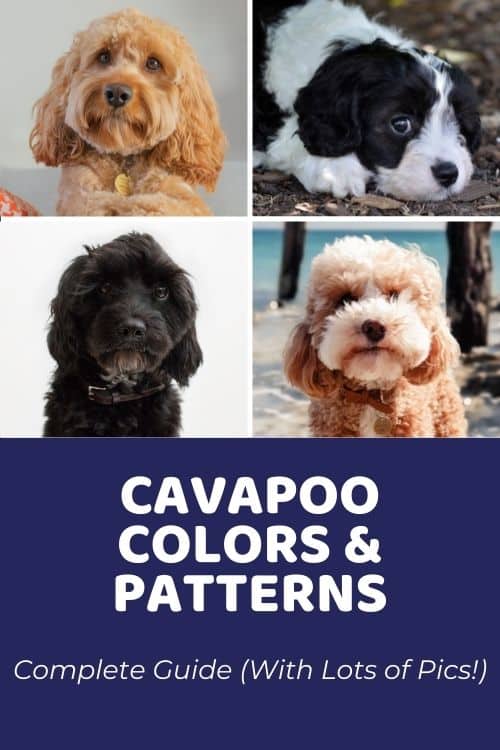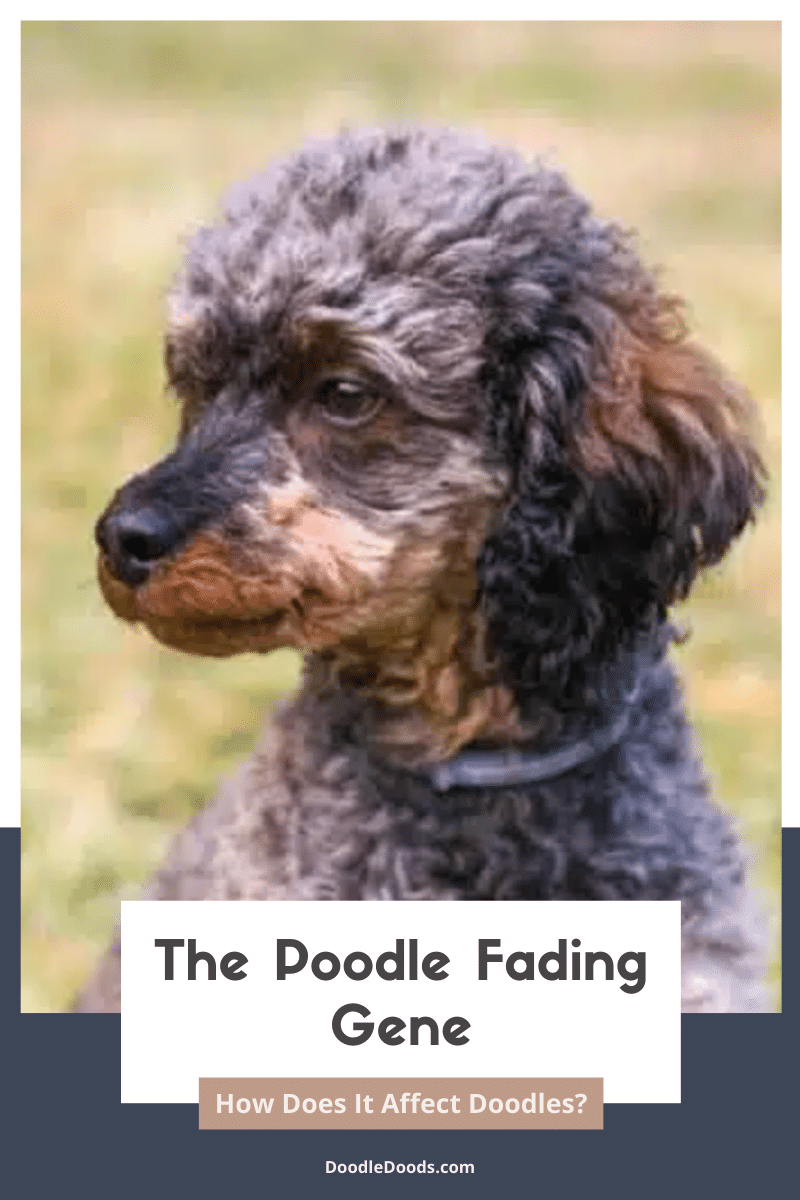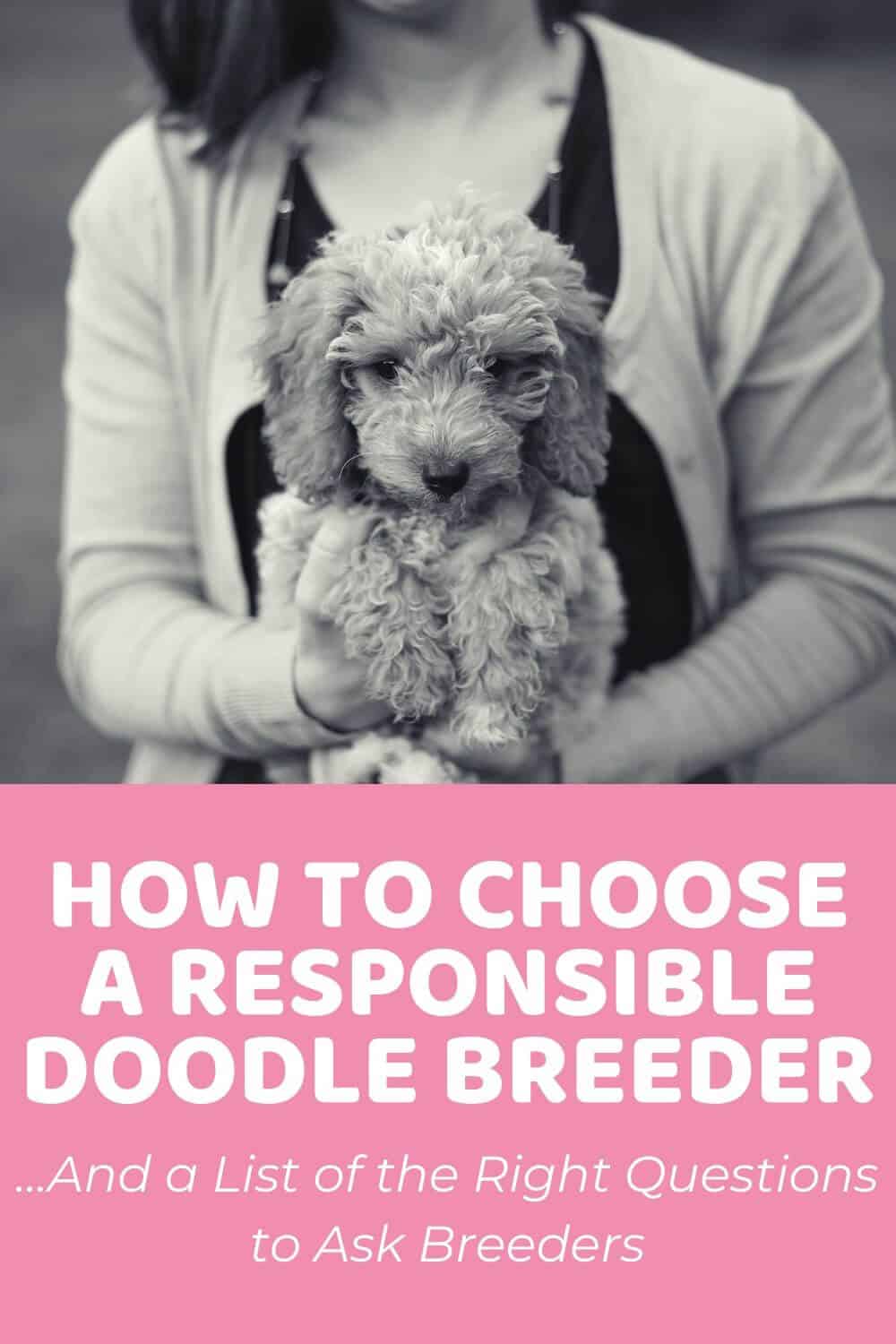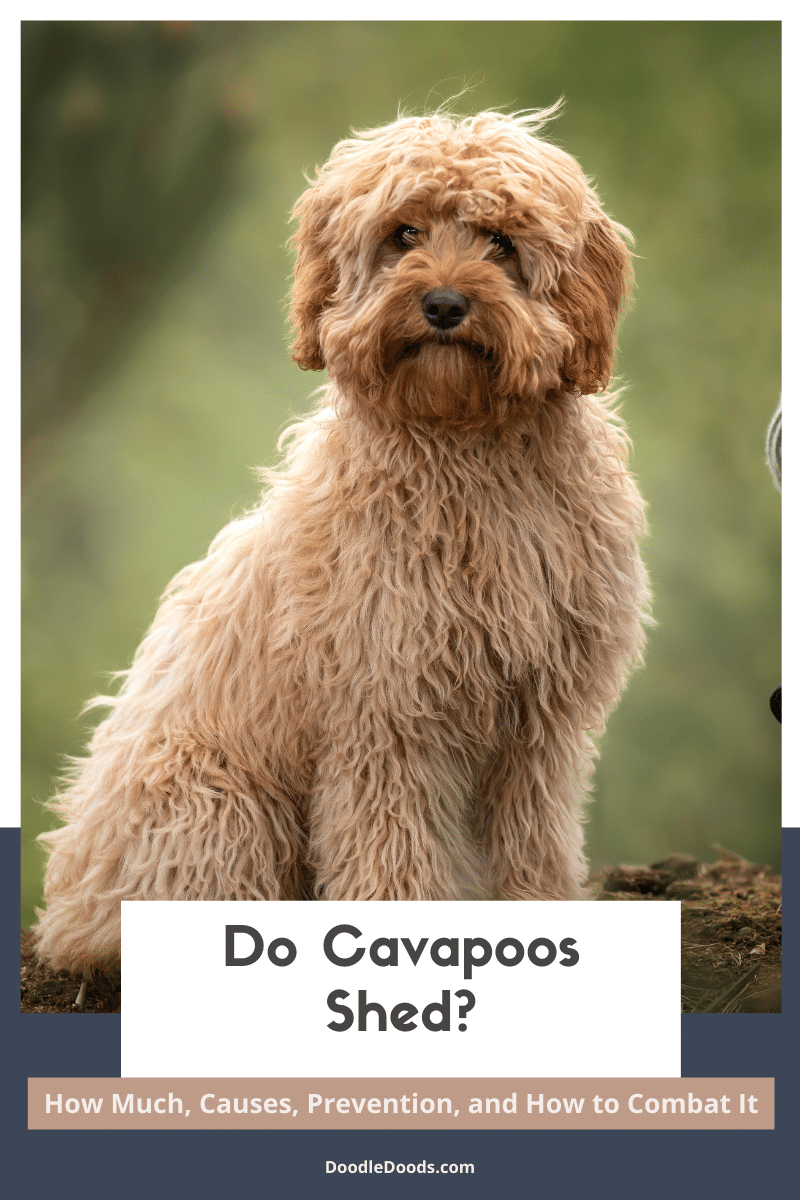If you’re determined to adopt this adorable Doodle pup, you’re probably now faced with the most difficult question – there are so many Cavapoo colors to choose from! Which one should you get?
In this guide, we’re going to discover all the possible Cavapoo colors and coat patterns. Of course, we’ll be linking to lots of pics of each of them, so you’ll know exactly what you’ll get. In addition to that, we’ll also be discussing whether or not a Cavapoo’s color can in any way affect their behavior, temperament, or health. Let’s get started!
Cavapoo Colors & Coat Patterns: Introduction
The adorable Cavalier King Charles Spaniel Poodle mix comes in a variety of colors and patterns. That’s what makes it so fun, you never know what you might get with Doodles! They might take their looks after the Poodle parent. Or, instead, they might resemble more of the Cavalier King Charles Spaniel parent.
Although each of us likely has our own preferences when it comes to Cavapoo colors and patterns, choosing between all of them is a difficult task. All of them look so cute and all of them make the pups look so beautiful in their own unique way.
That’s why we decided to round up all the possible Cavapoo colors and coat patterns, so you can have a closer look at each of them. Hopefully, this will also make your decision somewhat easier (or even more difficult than before…sorry! 😉 ).
Cavapoo Colors: Their Heritage
By combining two different purebred dogs, the varieties are almost endless when it comes to Cavapoo colors. Some Cavapoos sport the signature Cavalier colors while others flaunt more Poodle-like coats. It’s almost impossible to predict a Cavapoo’s color, as it all boils down to their genetics.
So, before we reveal to you all the Cavapoo colors, let’s quickly learn a bit more about their background and where these pups inherit their looks.
Cavalier King Charles Spaniel Colors
Officially, by AKC breed standards, Cavalier King Charles Spaniels come in four breed colors and markings. The most famous of them all is the signature Blenheim Cavalier King Charles Spaniel. These pups have a solid white base color with chestnut markings on their ears, eyes, and body.
The other official breed colors are black and tan, black and white, and ruby. The official markings are tan-colored. For instance, some Cavaliers come with a tri-color pattern, where black and white are also accompanied with tan markings. On the other hand, some pups come in a black and tan pattern along with white markings.
Very rarely, some Cavaliers are born with an all white coat, which is usually considered as a fault. These pups do have pigmentation on their nose, eyes, and toes, but not on the coat. Additionally, another rare coat color in Cavaliers is merle.
Poodle Colors
The majestic Poodle comes in various colors and color combinations. They can come in solid colors, such as apricot, black, blue, brown, cafe au lait, cream, gray, red, silver, or white.
The most common color combinations in Poodles include black and brown, black and cream, black and gray, black and silver, black and tan, black and white, blue and white, brown and white, cream and white, gray and white, red and white, red and apricot, white and apricot, white and silver, black and apricot, and brown and apricot.
In addition to that, by AKC breed standards, Poodles can also have colored markings, such as black points, a black mask, or a white mask.
Cavapoo Colors
As we learned, both Cavaliers and Poodles come in a variety of colors and coat patterns. So, what happens when we mix those two breeds together? Here’s our complete guide of all the Cavapoo colors and coat patterns.
Black Cavapoo
The Cavapoo black coat can either present as an all black solid color or black base color with white markings on the face, chest, and paws. An all black Cavapoo is more of a rarity, as it’s very difficult to come across a black Cavapoo that has no markings on their body.
The all black Cavapoo color comes from a recessive gene from the Poodle’s side of the lineage. So, even if a breeder crosses two black Cavapoos, it doesn’t necessarily guarantee that the puppies will inherit a black coat as well. However, one pup out of the litter might be the lucky one!
Black And White Cavapoo
The Cavapoo black and white coat is similar to the Cavapoo black coat, but these pups have more prominent white markings on the face, chest, and paws. The black and white color combination is found on both Poodles and Cavaliers, so it’s not uncommon for a Cavapoo to inherit this beautiful coat pattern.
The Cavapoo black and white coat can come in various patterns, such as abstract, parti, or tuxedo. For instance, the parti pattern refers to a color combination, where both colors take up about 50% of the body. The tuxedo pattern, as you might guess, makes it seem as if your pup is wearing a tuxedo.
White Cavapoos
Similarly to solid black Cavapoos, an all white Cavapoo is rather hard to find, although not impossible. To achieve a white Cavapoo, the Poodle parent used in the mix should also be all white.
However, usually white Cavapoos do have other colors in their coats. Sometimes the markings are cream, tan, or apricot, but they can also have black markings in the coat. Oftentimes, they come in the signature Cavalier color called Blenheim, where the pups have a solid white body with chestnut or lighter apricot and tan markings on their face, ears, and body.
Red Cavapoo a.k.a Ruby Cavapoo
Red Cavapoo or ruby Cavapoo is a nod to the Cavalier King Charles Spaniel parent. As we mentioned above, the rich red color common in Cavaliers is called ruby. Of course, Poodles can also come in various red tones.
Ruby Cavapoos can come in all red coats, but they often come with white or cream markings in their fur. The richness of red can vary. Some have darker, chestnut colored coats, whereas others lean on the lighter side of strawberry blonde.
Breeders can produce a red Cavapoo or ruby Cavapoo by using a ruby Cavalier and an apricot Poodle in the mix. Additionally, if a Cavapoo has inherited the fading gene from the Poodle parent, they might fade into lighter red hues as they grow up.
Tan Cavapoos
The tan Cavapoo color is in the same tonal range as red or ruby. They’re much lighter compared to ruby Cavapoos, almost as if the red in their coat is diluted. Tan Cavapoos are pretty common, as Cavaliers come in their signature ruby coats, while Poodles come in various shades of tan.
Cavapoos with a tan coat can come in all solid tan or with markings of white, apricot, or black in their coats. To achieve a tan Cavapoo, the Poodle parent used in the mix might be either cream or apricot colored.
Apricot Cavapoos
Depending on the lighting, apricot can look very similar to tan and even red Cavapoo colors. However, apricot Cavapoos have more of a peachy undertone in their fur. Like other similar Cavapoo colors, apricot Cavapoos can come with either solid apricot coats or with white, cream, red, or black markings.
Similarly to red Cavapoos, apricot Cavapoos can be achieved by mixing a ruby Cavalier with an apricot Poodle. But generally, not all pups in the litter will have the same coat color. Some might be more red, while others are more apricot.
Golden Cavapoos
Golden Cavapoos, again, might look very similar to tan and apricot Cavapoos. Typically, the golden hue is richer and darker than tan. And, as you might guess, instead of a peachy hue in apricot coats, their fur looks more golden. The gold tones are especially prominent when looking at your pup under the light.
Cream Cavapoo
The cream Cavapoo color is another similar tone to tan, apricot, and golden Cavapoos. However, cream Cavapoos are much lighter compared to all of them. These pups look almost white, but not quite. They can also have markings on their face, chest, body, and paws.
Chocolate Cavapoos
Chocolate Cavapoos have a rich, dark brown coat color. Most commonly, chocolate Cavapoos have white markings on their face, chest, body, and paws. Some pups might come in all solid chocolate coats, but these are generally very difficult to come across. Even chocolate Cavapoos with markings are quite rare.
To achieve a chocolate Cavapoo, breeders would use a dark brown Poodle in the mix. But as the brown Cavapoo color comes from a recessive gene, it’s not as easy to achieve this beautiful rich color.
Bi-Color Cavapoo
Bi-color Cavapoos are one of the more popular choices, as the bi-color pattern is prevalent in both Cavalier King Charles Spaniels and Poodles. The term bi-color refers to a Cavapoo having two colors in their fur.
Oftentimes, bi-color Cavapoos have the signature Blenheim Cavalier color, where most of the body is covered in white, along with patches of chestnut or red on the face, ears, and body.
Other common bi-color patterns in Cavapoos include black and white or black and tan. Some pups also have tan and white or apricot and white coats.
Tri-Color Cavapoo
Tri-color Cavapoos, on the other hand, come with three colors in their coats. The tri-color pattern is very similar to the bi-color pattern, but with another color included in the fur.
As we mentioned above, some Cavaliers come with tri-colored coats, where the main colors are black and white, accompanied with tan markings. This is also the most common version of the tri-color pattern in Cavapoos.
Other Cavapoos with the tri-color pattern can have shades of red, apricot, tan, and white in their coats.
Phantom Cavapoos
Phantom Cavapoos might look similar to bi-color and tri-color pups, but they actually come with a distinctive pattern. They usually have a darker dominant base color with lighter markings above the eyes and on the muzzle. This is a super rare Cavapoo color, but equally as adorable as any of the above.
Sable Cavapoos
Another one of the rare Cavapoo colors is the sable pattern. Sable Cavapoos have a solid base color, usually tan. However, their hair tips are black, which gives them a very interesting pattern.
Some sable Cavapoos might present darker, while others might look almost solid tan. It all depends how much of the hair length is colored black.
What’s more, sable Cavapoos almost always come with the fading gene. These pups usually grow out of their black hair tips, so they’ll be much lighter by the time they reach adulthood.
Blue Merle Cavapoo
Lastly, we have the extremely rare blue merle Cavapoo. Although very rare in both Poodles and Cavaliers, it’s not impossible to come across a blue merle Cavapoo. Blue merle Cavapoos have patches of a darker solid color with speckled patches of diluted lighter tones in their coats. Typically, the darker color is either black or blue, and the lighter colors seen on the coat are more grayish, silver, and white.
Do Cavapoo Puppies Change Color?
Like other Doodles, Cavapoo puppies can sometimes change color as they grow up. But compared to some other Doodle breeds, Cavapoos don’t always change color as they reach adulthood.
The color change typically happens because a Doodle has inherited the clearing gene or fading gene from the Poodle’s side of the lineage. Sometimes even the other purebred parent can carry the fading gene.
If a Doodle puppy has inherited the fading gene, they will often fade lighter somewhere between 6 and 12 months old. The fading is more common in darker colored Doods, especially pups who have black, dark brown, or blue in their coat. For example, black Cavapoos may turn into more blue, gray, and silver tones. Similarly, chocolate Cavapoos may fade into lighter tones, such as cream.
On the other hand, Cavaliers often mature into darker, richer colors as they grow up. So, Cavapoos don’t necessarily change color as they become adults. On the other hand, if they have inherited the fading gene from the Poodle’s side of the lineage, they might fade lighter by the time they’re fully-grown.
Moreover, Cavapoos with a sable coat generally do inherit the fading gene. These pups are most prone to fading, and more often than not, they do change color during their first year.
Does Coat Color Affect Cavapoo’s Health And Behavior?
Although some people might say that a certain Cavapoo color is better because it influences a dog’s behavior, there’s no scientific evidence to prove that. Above all, the color of your pup hasn’t got much to do with their personality or how they behave. All dogs have their own unique personalities. And, of course, each dog has certain behavioral quirks.
However, the only Cavapoo color that is linked to certain health issues is merle. The merle gene is associated with blindness and deafness, so if you’re after this particular color of Cavapoo, make sure you choose an ethical, reputable breeder who does extensive health and genetic testing on their breeding dogs beforehand.
Additionally, as the merle gene comes with its risks, ethical breeders will not cross two merle Cavapoos together. Again, the key here is thorough health and genetic testing to minimize the risks.
Cavapoo Colors: Which One Should You Get?
If you’ve got your heart set on a Cavapoo then choosing the color of your pup is likely the final big question before adoption. Or maybe you’ve always known exactly what color you’re after. So, which one should you get? It’s as simple as choosing whatever color you prefer.
On the other hand, you shouldn’t choose a puppy only based on their coat color. In fact, ethical breeders usually do temperament testing before adoption, so each puppy goes into a home that suits their personality and the family’s lifestyle.
Of course, breeders usually take into account your preferences, but we wouldn’t advise you to only choose your new puppy based on their looks. All Cavapoos are cute anyway, regardless of their color! And after all, you’ll want to spend the next 12 to 15 years with a Dood that meshes well with your personality, lifestyle, and family dynamics.
Cavapoo Colors: Frequently Asked Questions
What Is The Most Desired Cavapoo Color?
The most desired Cavapoo color is thought to be the ruby Cavapoo. They come in a rich, dark red-toned coat that usually doesn’t fade or change color. Of course, other rare Cavapoo colors are also extremely sought-after.
What Is The Rarest Cavapoo Color?
The rarest Cavapoo colors include all solid black Cavapoo, chocolate, and white, but also unique patterns like phantom, sable, and merle.
For those rare Cavapoo colors, be prepared to pay extra, as many are after these unique patterns and coat colors. Usually, breeders who do specialize in rare Cavapoo colors, only have one or two Cavapoos with rare colors per litter, tops.
Do Cavoodles Get Lighter Or Darker?
This one’s a bit tricky, as on one hand, Cavaliers are known to get darker and richer in color as they become older. On the other hand, we have Poodles, who are notorious for fading as they grow up. It all depends on your pup’s genetic makeup. However, usually breeders do warn future Cavapoo owners if their pups might turn lighter and fade as they start reaching adulthood.
Cavapoo Colors: Final Thoughts
Choosing between all the possible Cavapoo colors is not an easy task, that’s for sure. Above all, you should choose a puppy that comes from an ethical breeder, a healthy background, and has a temperament that suits your lifestyle. But regardless of the color you decide on, we’re sure that your new puppy will look absolutely gorgeous. With Cavapoos, you can never go wrong.
Learn How to Care for Your Doodle Puppy!

Perfect for first-time Doodle parents, get ALL your questions answered, including questions new Doodle parents don’t even think to ask.
Plus, get $700 worth of Bonus Materials for FREE, including:- Doodle Parenthood Community and Support Group ($190 value)
- Doodle Puppy Growth Tracker ($20 value)
- EMERGENCY Cheatsheet: When To Call The Vet Immediately ($50 value)
- HELP! Button ($145 value)
- And SO MUCH MORE!





This is a great guide! I’m looking forward to trying out some of the different colors and coat patterns.
September 25, 2023 at 4:02 pm